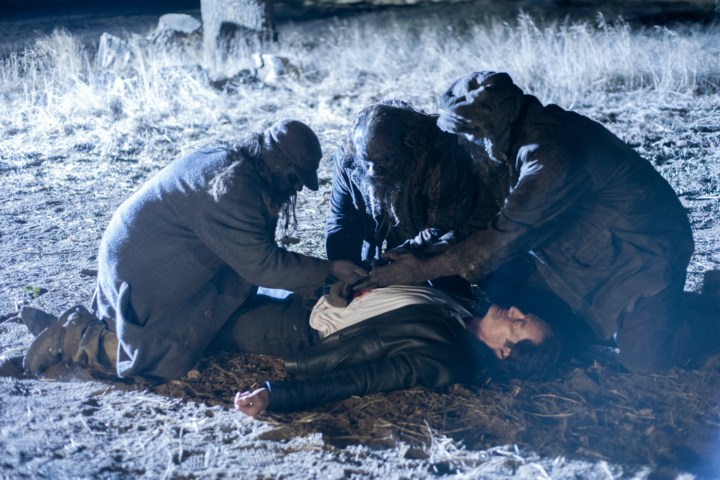
That’s what makes Part 8 so fascinating. If a viewer is hoping for forward movement in Agent Cooper’s story, or ready answers to any of the pestilential questions the show has raised, this episode provides neither. What it does offer is a stunning experiment in form, and perhaps even an origin story for the evils that plague the world of Twin Peaks.
A dark (but conventional) beginning
Part 8 begins with Cooper’s doppelgänger and Ray, fresh off their early release from jail, driving down a dark and winding road. No director makes the simple act of driving feel as sinister as David Lynch does. The world outside the car is pitch black, the headlights making a shallow cut in the darkness.
The doppelgänger learned in an earlier episode that Ray and his now-deceased compatriot Darya were working for someone else, with orders to kill him, and this knowledge hangs over the scene as Ray and the doppelgänger discuss some important information Ray has, and where Darya is at the moment.
The situation does not bode well for Ray, who pulls over in a clearing to take a piss, during which the doppelgänger approaches him with a gun, demanding the intel. Ray tampered with his gun, however, and produces one of his own, shooting him.
Because this is Twin Peaks, where simple resolutions are impossible, a swarm of shadowy men like the one who has been haunting those involved with the Garland Briggs murder case, appear from the forest and act as if they are devouring the doppelgänger’s body. Ray flees the scene, making a call to the long missing Phillip Jeffries, last seen in the Twin Peaks film, Fire Walk with Me.

The doppelgänger isn’t dead, however. He wakes after the shadow men’s ritual — and a performance by Nine Inch Nails — and the episode veers suddenly into New Mexico, 1945. The detonation of a nuclear bomb is rendered in stark black and white, as the opening strings of Threnody for the Victims of Hiroshima screech.
2017: A Lynch Odyssey
What follows is a lengthy — twenty minutes or so — odyssey through light and sound, as clouds swell and black spots flutter around the screen like flies. The sequence feels like an homage to the famous star gate sequence in Kubrick’s 2001: A Space Odyssey, and it also provides a hint at the origin of Twin Peaks’ most notable villain, BOB. At one point in the scene, a feminine creature resembling the apparition that appeared in the glass box in the first episode vomits forth a white stream containing eggs and a dark sphere with BOB’s face in it.
After the chaos, the episode returns to the metal building in the purple sea, which Cooper visited earlier. A woman in an ornate dress is there, as is the Giant, who watches the sequence of BOB’s creation on an old projection screen. He conjures a golden orb containing Laura Palmer’s face, which the woman embraces before casting it into the screen, where it appears to fall to earth.

Time skips forward to 1956, where one of the eggs from the previous sequence hatches — a grotesque creature, composed of pieces of a fly and a frog, crawls forth. In the nearby town, a host of those dark spirits from earlier appear. One makes its way to a radio station, killing the people within and broadcasting a bizarre message over the airwaves, the sound of which puts listeners to sleep.
What to make of this craziness? Despite the long stretch of experimental filmmaking, and the fact that much of the episode follows characters far away in time and space from the show’s regulars, it does seem to serve a large role in the overarching narrative of Twin Peaks, suggesting that BOB was created by mankind’s experimentation with nuclear weapons, or at least that those projects allowed him to cross into the physical world.
The spirits of the Black Lodge are an enigmatic folk, but this episode suggests that the Giant, who has been helpful to Agent Cooper throughout the series in his cryptic way, may be a sort of guardian angel, sending aid to the earth when BOB arrives.
Twin Peaks tries ’50s sci-fi
The nuclear angle is an interesting one. In an age where climate change and pollution are so prominent in the news, modern viewers may not be accustomed to the anxieties of the Cold War, when humanity feared that its ingenuity, rather than its vices, could be its undoing. Despite years of arms treaties, nuclear weapons remain plentiful, and Twin Peaks is stoking fears about an old, but still very present, threat. Given the presence of a prominent photo of a nuclear bomb in FBI director Gordon Cole’s office in Part 7, nuclear annihilation seems to be at the forefront.
Lynch has never been a didactic storyteller, however, and Twin Peaks shows — rather than tells — the viewer the ferocity of the bomb. The show even uses a daring experiment in form to to do so. The 1956 sequence at first seems even less connected to the overarching narrative than the experimental film portion — at least those scenes featured figures like BOB and the Giant.

While the 1956 sequence does not immediately fit into the plot, it does accentuate the theme of nuclear peril through a twist in genre. The sequence, filmed in black and white, follows a small town invaded by dangerous creatures, years after a nuclear test nearby. It is essentially a ‘50s sci-fi horror film, like Them! or The Beast from 20,000 Fathoms. Lynch and writer Mark Frost perform their own take on the genre within this episode.
In a lengthy essay for the magazine Premiere in 1996 called David Lynch Keeps His Head, David Foster Wallace tackles a common critique of Lynch’s films: That they are lacking a moral compass. Wallace contends that Lynch’s films actually do explore moral truths, resisting the popular and easy framework in which some people choose to be evil and instead suggesting that evil is a force as essential to the universe as gravity. As Wallace explains [Note: This section comes from a longer version published in A Supposedly Fun Thing I’ll Never Do Again:
People can be good or bad, but forces simply are…Evil for Lynch thus moves and shifts, pervades; Darkness is in everything, all the time — not “lurking below” or “lying in wait” or “hovering on the horizon”: evil is here, right now. And so are Light, love, redemption…It’s not just that evil is “implied by” good or Darkness by Light or whatever, but that the evil stuff is contained within the good stuff, encoded in it.
The first nuclear test, in which human genius created a weapon that could destroy humanity, fits perfectly into that framework. The bomb represents humanity’s ingenuity and mastery of the world around it, but also its capacity for destruction, and it opens the door for BOB to enter the world. Although modern viewers may not appreciate the esoteric presentation, that’s part of the show’s beauty; Twin Peaks does not care for the conventions or constraints of television storytelling.
Want to get into ‘Twin Peaks,’ but not sure where to start? Consult our primer for the essential episodes. You can also check out our previous three explainer pieces below.
Editors' Recommendations
- Wait, David Lynch directed a commercial for the Sony PlayStation?
- Steven Spielberg casts David Lynch in The Fabelmans


